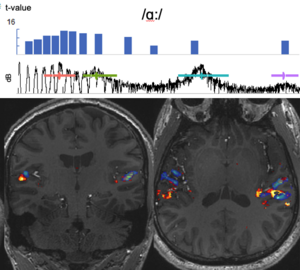Gradient vs. Categorical Perception
In this project, we attempt to map the perceptual profiles of native listeners by correlating acoustic discrimination and phoneme categorisation responses with the listeners’ brain structure and functional activation patterns.
Neural and behavioural differences in native phonetic and phonological processing

This project investigates how the processing of speech sounds goes from acoustic analysis to top-down categorical perception. The main aims are to test the Dual-Complexity Gradient theory of speech perception (Roll 2018) and to detail the individual variation of sound processing patterns.
Categorical perception (and discardment of category-irrelevant acoustic information) has traditionally been considered universally beneficial in psychophonetic research. Recent studies show, however, that some individuals with high linguistic function retain more detail during speech decoding, demonstrate gradient categorisation, and benefit from it in realistic speech contexts. We are collecting MRI and behavioural data from native Swedish participants in order to gauge the performance variability in acoustic and phonemic processing, map the perceptual profiles of native listeners, and compare them with functional activation patterns and measures of brain structure.
